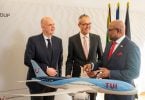The invitation of Saudi Foreign Minister Saud Al-Faisal to his Iranian counterpart to visit Riyadh for talks, arrests of 62 terrorists by Saudi Intelligence, and the stepping down of legendary Prince Bander from the post of the Chief of Saudi Intelligence are highly important developments that are taking place in the Middle East in the backdrop of US-Iran direct talks. A perceivable change and shift in the foreign policy of Saudi Arabia is perhaps driven by the known resolve of Saudi Interior Minister and possible next King, Prince Mohammed bin Nayef, that terrorists have their own agendas to destabilize every Islamic state.
“Fire has reached home, and Saudis now after busting [the] terrorist network within its borders, understand that terrorists are working on bigger agendas by using every sect, group, nationality, and country for their own purposes,” commented a former diplomat when asked to comment on rapid developments in Middle East.
Saudi Arabia being ready to talk with Iran is a positive and encouraging development, and diplomatic circles believe that Pakistan Prime Minister Mian Nawaz Sharif has played a very important role to push Iran and Saudi Arabia closer at the diplomatic level through back channel diplomacy.
Political observers believe that Pakistan has a global hotspot regarding training purist radical Islamists, transferring them to other conflicts areas, and creating uprisings since the 1979 Afghan Russo war. Pakistan became a frontline state for disintegrating the former USSR when the entire western world provided training, resources, and diplomatic support to the then Mujahideen that ultimately were called as terrorists by the operators and trainers after the tragic 9/11. After the end of Afghan Jihad, thousands of Arabs, mostly Saudis, Yemenis, Palestinians, and Sudanese, preferred to stay in Afghanistan and in restive tribal areas of Pakistan for a cause – installation of true purist Islamic states in the region including in some parts of Central Asia.
These groups tried to destabilized governments of Central Asia for almost a decade but were successfully rooted out from Uzbekistan and Tajikistan and then again they came back to their safe heaven – tribal areas of Pakistan. Thousands of young Palestinians and Saudis and Sudanese were forefront fighters and many of them were granted admission to Peshawar University after the end of the Afghan Jihad, earning degrees in religious studies, engineering, and languages. They spread over Pakistan from Karachi to Peshawar, and now they host other friends to arrive and operate in this region. This whole region has been under the cloud of terrorism since then. Experts believe that these radicals were sponsored and supported directly or indirectly by groups sitting in Saudi Arabia and Gulf States for the installation of a Saudi form of Islam in Pakistan, Central Asia, and to keep putting pressure on Iran. These groups engineered more radical sectarian groups, and a wave of killing of Shias in Pakistan started in the early 90s. This wave became a hurricane in Pakistan. Former bureaucrats in Islamabad claim that this was possible only because of moral, religious, and philosophical support of Saudi Arabia. Some people even allege Saudi Arabia received financial support of anti-Shia groups in Pakistan like Lashkar-e-Jhangvi and even Tehrik-i-Taliban Pakistan (TTP).
Saudi Arabia’s official press in first week of May confirmed that it had apprehended the first terrorist cell affiliated to the outlawed Islamic State of Iraq and Syria (ISIS) group, arresting a total of 62 suspects, including 35 Saudi nationals previously detained on terrorist-related charges. Riyadh designated ISIS, an Al-Qaeda splinter group, as a terrorist organization in early March.
This biggest catch of such a strong terrorist network was announced just 15 days after the removal of Prince Bandar, the chief of Saudi Intelligence. People consider removal or stepping down of Bandar as one of the biggest developments in Saudi Arabian intelligence networking. Experts claim there is a link between the two events.
Prince Bandar, popularly known as “Bandar Bush” due to his close relations with the Bush family, had been a Saudi ambassador to the US for 22 years. He is a legendary networker and hawk dealing closely with terrorist organizations, allegedly harboring and sponsoring them in different regions of the world including Russia, Pakistan, Iran, Syria, and African states. The Saudi media said Bandar stepped down at his own request. He is replaced by his deputy Youssef bin Ali al-Idrisi, who is not from the royal family. According to diplomatic circles, Bandar faced strong opposition from the powerful Interior Minister (and possible future king), Prince Mohammed bin Nayef, who led the crackdown on al-Qaida following a wave of attacks between 2003 and 2006. Bin Nayef became increasingly concerned about battle-hardened young Saudis returning home radicalized after fighting in Syria. Nayef believes that terrorists are not friends of anybody, and they do not want to impose Saudi Arabian rule anywhere. They would rather that terrorists have their own agendas as they want to control the whole world, including power in Saudi Arabia. Recent arrests of terrorists in Saudi Arabia after the removal of Prince Bandar can be considered an important eye opener for Saudis that philosophy and resolve of Prince Nayef is correct and now fire has reached their own camps. The list of arrested people also indicates that global terrorists who were allegedly harbored by Prince Bandar for Syria, Iran, Pakistan, and Russia, were actively operating in Saudi Arabia to topple the Saudi government.
Interior Ministry of Security spokesman Maj. Gen. Mansour Al-Turki confirmed that the ISIS cell was in contact with Al-Qaeda cells in both Yemen and Syria – places where Prince Bandar was in contact with these groups and using them against Shias. Turki further confirmed that Saudi authorities arrested the “emir,” or leader, of the ISIS cell in Saudi Arabia, adding that three foreign nationals were among those held, including a Palestinian, a Yemeni, and a Pakistani national. Forty-four others are believed to be on the run. Saudi authorities also dismantled a factory the group was using to manufacture explosives and electronic detonators, in addition to seizing close to nearly 1 million Saudi riyals in cash. It is strange that such factories and people were not on the radar of Prince Bandar who is considered a hawk and architect of many terrorists groups.
www.dnd.com.pk
(eTN): Is the Middle East reshaping? | re-post license | post content






















